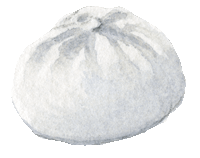mantou and baozi

Form: Small bread, sometimes filled
Country of origin: China
What distinguishes it from other methods of bread making: Made with leavening agent, steam-cooked, sometimes fried after steam-cooking, usually in form of bun
Category of bread: (7) There are few examples of traditional steamed breads. Examples include the mantou or baozi in China, the kluski na parze in Poland, and the dimo or trimo in Tibet and Ladakh. These breads are sometimes have filling.
Particularity: Kept warm over a steamer, they are a normal part of Northern Chinese eating, for young and old alike
Ingredients: wheat flour, baker’s yeast; warm water; milk, and sugar. Cooked in a steam cooker.

China
The presence of steamed wheat bread in China, referred to as bing, baozi or mantou, is confirmed starting from the age of Confucius, the sixth century, demonstrating that the Chinese do not only eat rice as carbohydrate. The origin of mantou is related to a dramatic episode in Chinese history.
The Han dynasty had just fallen around the year 220. China went through a painful transition. Three kingdoms were at war for domination of the Middle Empire. A brilliant general, Zhuge Liang, who served the Shu empire, distinguishes himself by a singular act that concerns major historical events as well as minor day-to-day history. When crossing a river, he had a custom of cutting off a few heads and offering them to the god who reigned over the place. Just as he was getting ready to cut off a few heads, he had some of these wheat buns filled with meat and steam-cooked. Who knows why; perhaps there weren’t enough prisoners to sacrifice, or perhaps he was just tired on the blood baths. In lieu of throwing human heads into the river, he threw the buns in. That’s how mantou got the name it so deserves, because the word means “head that tricks the god of the river.”
In our time, mantou most often has no filling, except in Shanghai, while baozi (meaning literally “little bag”) is filled with meat, vegetables and sometimes both; with red bean paste, etc. People of all ages like baozi. They eat them for breakfast; they eat them as snacks.

